Java Class, methods, instance variables
Java Declaration and Access Modifiers
All computer programs consist of two elements: code and data. Furthermore, a program can be conceptually organized around its code or around its data. The first way is called process-oriented model. Procedural languages such as C employ this model to considerable success. To manage increasing complexity the second approach called object-oriented programming was conceived. An object-oriented program can be characterized as data controlling access to the code. Java is object-oriented programming language. Java classes consist of variables and methods (also known as instance members). Java variables are two types either primitive types or reference types. First, let us discuss how to declare a class, variables and methods then we will discuss access modifiers.
Declaration of Class:
A class is declared by use of the class keyword. The class body is enclosed between curly braces { and }. The data or variables, defined within a class are called instance variables. The code is contained within methods. Collectively, the methods and variables defined within a class are called members of the class.
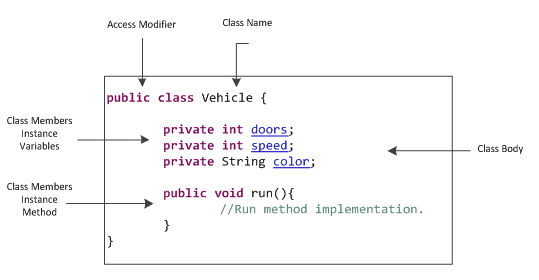
Declaration of Instance Variables :
Variables defined within a class are called instance variables because each instance of the class (that is, each object of the class) contains its own copy of these variables. Thus, the data for one object is separate and unique from the data for another. An instance variable can be declared public or private or default (no modifier). When we do not want our variable’s value to be changed out-side our class we should declare them private. public variables can be accessed and changed from outside of the class. We will have more information in OOP concept tutorial. The syntax is shown below.
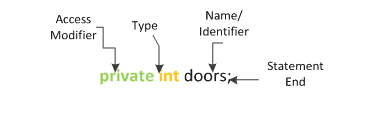
Declaration of Methods :
A method is a program module that contains a series of statements that carry out a task. To execute a method, you invoke or call it from another method; the calling method makes a method call, which invokes the called method. Any class can contain an unlimited number of methods, and each method can be called an unlimited number of times. The syntax to declare method is given below.

Access modifiers:
Each object has members (members can be variable and methods) which can be declared to have specific access. Java has 4 access level and 3 access modifiers. Access levels are listed below in the least to most restrictive order.
public: Members (variables, methods, and constructors) declared public (least restrictive) within a public class are visible to any class in the Java program, whether these classes are in the same package or in another package. Below screen shot shows eclipse view of public class with public members.
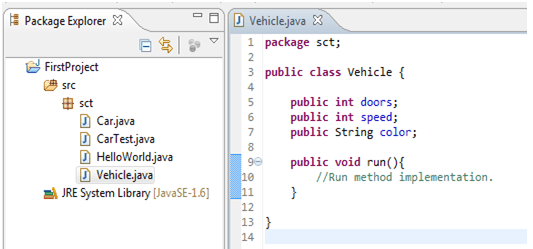
protected: The protected fields or methods, cannot be used for classes and Interfaces. Fields, methods and constructors declared protected in a super-class can be accessed only by subclasses in other packages. Classes in the same package can also access protected fields, methods and constructors as well, even if they are not a subclass of the protected member’s class.
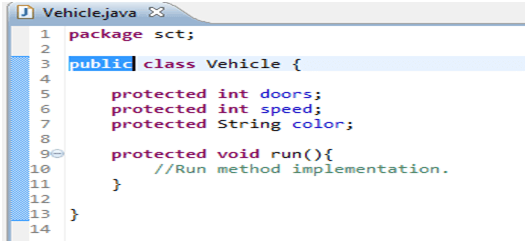
Default (no value):The default access level is declared by not writing any access modifier at all. Any class, field, method or constructor that has no declared access modifier is accessible only by classes in the same package.

private: The private (most restrictive) modifiers can be used for members but cannot be used for classes and Interfaces. Fields, methods or constructors declared private are strictly controlled, which means they cannot be accessed by anywhere outside the enclosing class.

Java has modifiers other than access modifiers listed below:
static: static can be used for members of a class. The static members of the class can be accessed without creating an object of a class. Let's take an example of Vehicle class which has run () as a static method and stop () as a non-static method. In Maruti class we can see how to access static method run () and non-static method stop ().
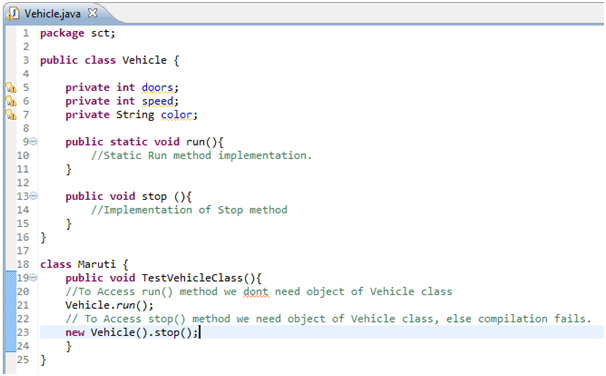
final: This modifier applicable to class, method, and variables. This modifier tells the compiler not to change the value of a variable once assigned. If applied to class, it cannot be sub-classed. If applied to a method, the method cannot be overridden in sub-class. In below sample, we can see compiler errors while trying to change the value of filed age because it is defined as final while we can change the value of name field.

abstract: There are situations in which you will want to define a superclass that declares the structure of a given abstraction without providing a complete implementation of every method. This modifier is applicable to class and methods only. We will discuss abstract class in detail in separate Tutorial.
Below Table summarizes the access modifiers
| Modifier | class | constructor | method | Data/variables |
|---|---|---|---|---|
| public | Yes | Yes | Yes | Yes |
| protected | Yes | Yes | Yes | |
| default | Yes | Yes | Yes | Yes |
| private | Yes | Yes | Yes | |
| static | Yes | |||
| final | Yes | Yes |
Let’s take first column example to interpret. A “class” can have public, default, final and abstract access modifiers.
Summary
- Access modifiers help to implement encapsulation principle of object orientation programming.
- Java has 4 access modifiers public, protected, default, private.
- Java has other modifiers like static, final and abstract.
Previous: Compiling, running and debugging Java programs
Next: Java Packages
